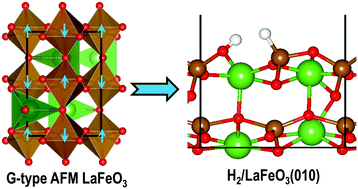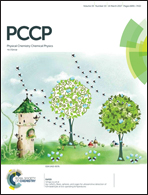A DFT+U investigation of hydrogen adsorption on the LaFeO3(010) surface
Abstract
The ABO3 perovskite lanthanum ferrite (LaFeO3) is a technologically important electrode material for nickel–metal hydride batteries, energy storage and catalysis. However, the electrochemical hydrogen adsorption mechanism on LaFeO3 surfaces remains under debate. In the present study, we have employed spin-polarized density functional theory calculations, with the Hubbard U correction (DFT+U), to unravel the adsorption mechanism of H2 on the LaFeO3(010) surface. We show from our calculated adsorption energies that the preferred site for H2 adsorption is the Fe–O bridge site, with an adsorption energy of −1.18 eV (including the zero point energy), which resulted in the formation of FeOH and FeH surface species. H2 adsorption at the surface oxygen resulted in the formation of a water molecule, which leaves the surface to create an oxygen vacancy. The H2 molecule is found to interact weakly with the Fe and La sites, where it is only physisorbed. The electronic structures of the surface–adsorption systems are discussed via projected density of state and Löwdin population analyses. The implications of the calculated adsorption strengths and structures are discussed in terms of the improved design of nickel–metal hydride (Ni–MH) battery prototypes based on LaFeO3.



 Please wait while we load your content...
Please wait while we load your content...